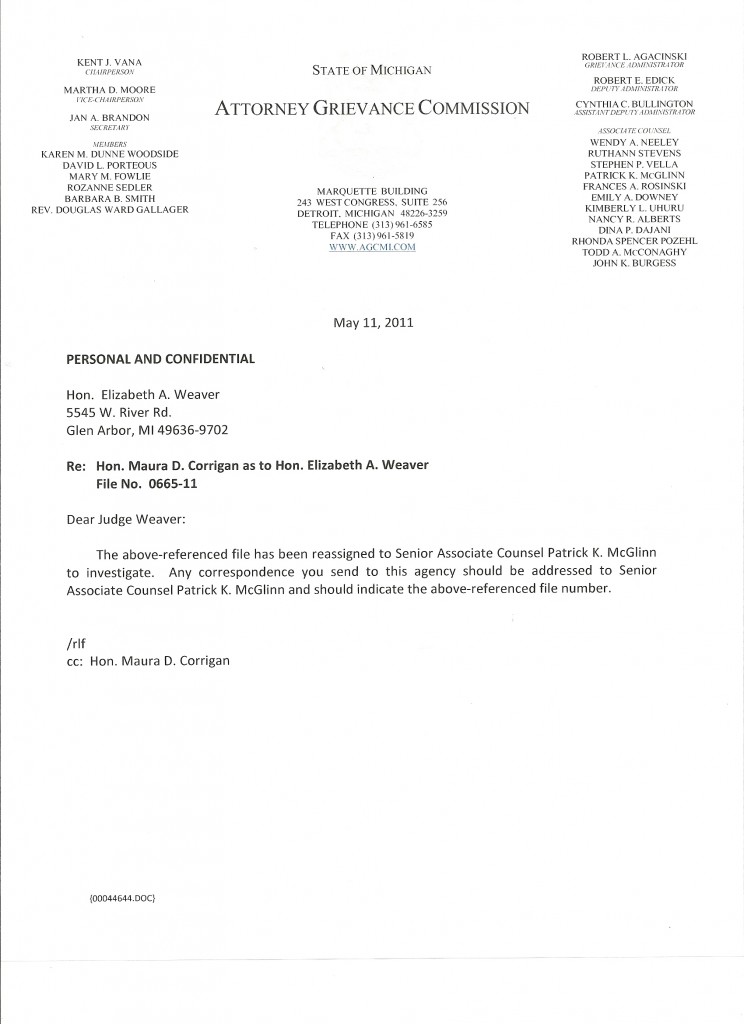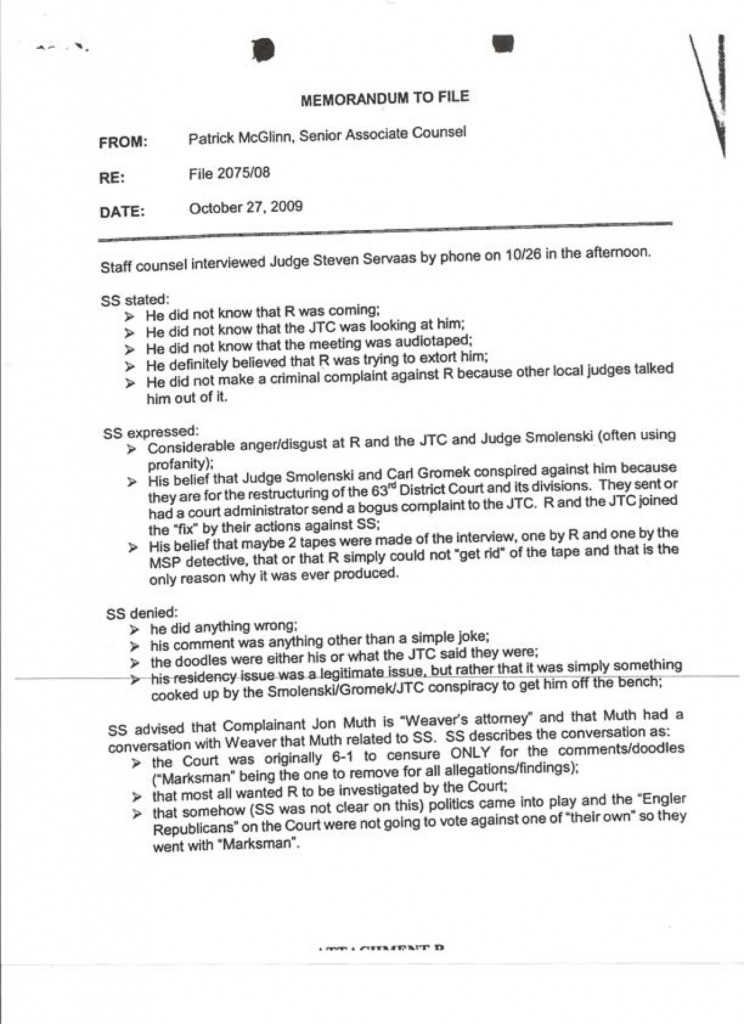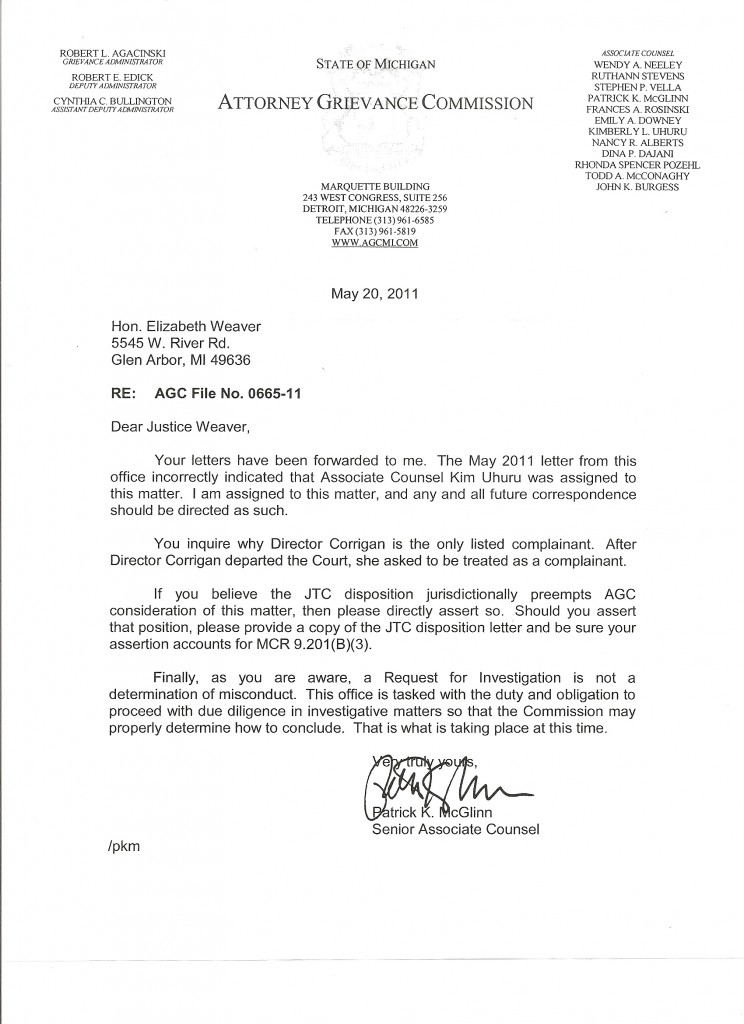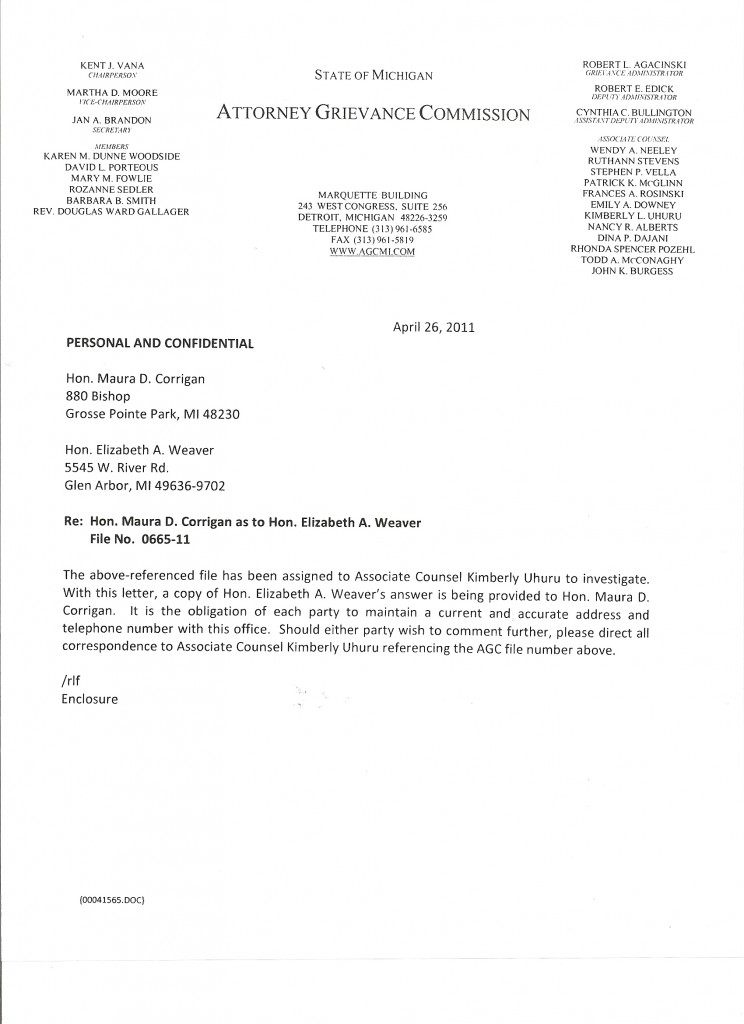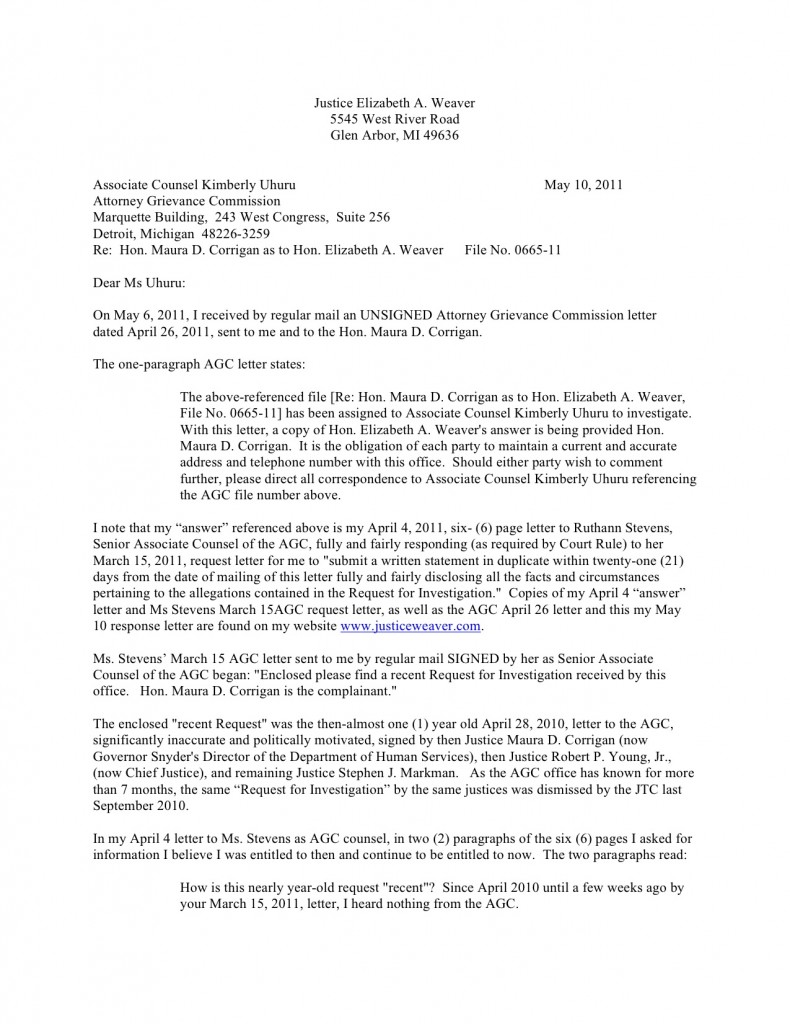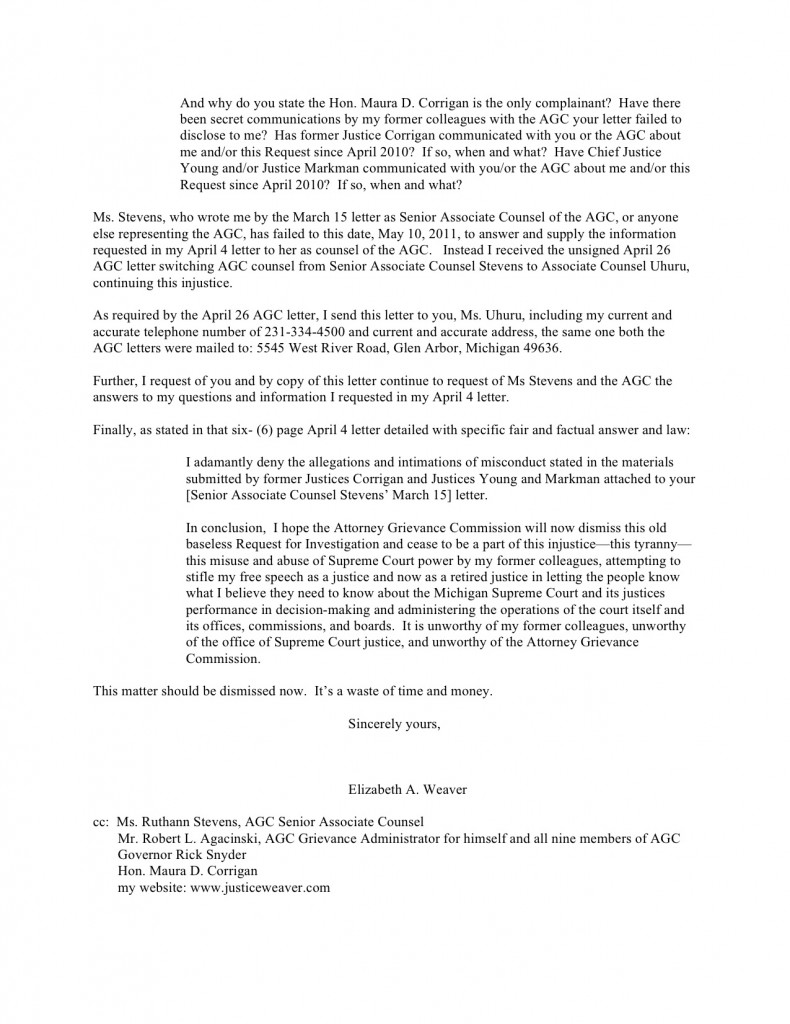Okay, here it is, Justice Elizabeth Weaver’s response to Patrick McGlinn of the Attorney Grievance Commission. (And all this is available at her own website, www.justiceweaver.com.) I have a couple of observations and questions at the end.
Justice Elizabeth A. Weaver
5545 W. River Road
Glen Arbor, MI 49636
Senior Associate Counsel Patrick K. McGlinn June 6, 2011 Attorney Grievance Commission Marquette Building, 241 West Congress, Suite 256
Detroit, Michigan 48226-3259
Re: Hon. Maura D. Corrigan as to Hon. Elizabeth A. Weaver File No. 0665-11
Dear Mr. McGlinn:
I have received by regular mail two (2) more letters from the Attorney Grievance Commission (AGC): one unsigned AGC letter dated May 11, 2011; the other signed by you, Mr.McGlinn, dated May 20, 2011.
The two (2) sentence May 11, 2011, AGC letter states: Dear Judge Weaver: The above-referenced file [Hon. Maura D. Corrigan as to Hon. Elizabeth A. Weaver File No.0665.11] has been reassigned to Senior Associate Counsel Patrick K. McGlinn to investigate. Any correspondence you send to the agency should be addressed to Senior Associate Counsel Patrick K. McGlinn and should indicate the above-referenced file number.”
The four (4) paragraph May 20, 2011, AGC letter begins: Dear Justice Weaver: Your letters have been forwarded to me. The May 2011 letter from this office incorrectly indicated that Associate Counsel Kim Uhuru was assigned to this matter. I am assigned to this matter, and any and all future correspondence should be directed as such.”
Within the last three (3) months, there are now seven (7) letters (4 from the AGC and 3 from me) in this matter. They are:
- AGC letter dated March 15, 2011, signed by Senior Associate Counsel Ruthann Stevens requiring a full and fair accurate response within 21 days to the Request for Investigation enclosed and dated April 28, 2010;
- My six (6) page letter dated April 4, 2011, fully, fairly and accurately responding to AGC Senior Associate Counsel Stevens;
- AGC letter dated April 26, 2011, unsigned assigning for investigation the matter to Associate Counsel Kimberly Uhuru and requiring my current and accurate address and phone number and any response to her;
- My two (2) page letter dated May 10, 2011, responding to AGC Counsel Uhuru;
- AGC unsigned letter dated May 11, 2011, reassigning the matter to Senior Associate Counsel, Patrick K. McGlinn;
- AGC letter dated May 20, 2011, signed by Senior Associate Counsel, Patrick K. McGlinn requiring response to him;
- This, my five (5) page June 6, 2011, letter to you, Mr. McGlinn, AGC Senior Associated Counsel responding to AGC May 11 and your May 20, 2011 letters.
Copies of all seven (7) letters are on my website: www.justiceweaver.com.
I write to you, Mr. McGlinn, as required to note and respond as follows:
First, as stated in each of my previous letters, I adamantly deny the allegations and intimations of misconduct stated in the materials dated April 28, 2010, and submitted by former Justice Corrigan and Justices Young and Markman attached to AGC Senior Associate Counsel Stevens’ March 15, 2011, letter.
All seven (7) letters concern the now over one year old April 28, 2010, letter to the AGC, significantly inaccurate and politically motivated, alleging and intimating misconduct by me and signed by then-Justice Maura D. Corrigan (now Governor’s Snyder’s Director of the Department of Human Services), then-Justice Robert P. Young, Jr. (now Chief Justice), and remaining Justice Stephen J. Markman. As the AGC has known for more than eight (8) months, the same Request for Investigation” by the same justices was dismissed last September (2010) by the Judicial Tenure Commission (JTC) without any recommendation of a sanction.
The March 15, 2011, AGC Stevens letter begins: Enclosed please find a recent Request for Investigation received by this office. Honorable Maura D. Corrigan is complaint.” (Emphasis added.) The enclosure is dated April 28, 2010.
Your May 20, 2011, letter states: …a Request for Investigation is not a determination of misconduct. This office is tasked with the duty and obligation to proceed with due diligence in investigative matters so that the Commission may properly determine how to conclude.” (Emphasis added.)
Also, your May 20 letter states: You inquire [in my April 4 letter] why Director Corrigan is the only listed complainant. After Director Corrigan departed the Court, she asked to be treated as a complainant.” Since Justice Corrigan had to depart the court after noon January 1, 2011 (or Governor Granholm rather than Governor Snyder would have had the right to appoint the vacancy left by her departure), as requested in my April 4, letter exactly what date did Justice Corrigan ask to be treated as a complainant”? Was it written or oral? Was it before or after she assumed her office of Director of the Department of Human Services? Governor Snyder announced her appointment January 6, 2011. (I also note no one from the AGC in any of the AGC letters to me has answered my April 4 questions: Have Chief Justice Young and/or Justice Markman communicated with you or the AGC about me and/or this Request [for Investigation] since April 2010? If so when and what?” I again request the AGC answer.)
Regardless of whether former Justice Corrigan reasserted in January, February, or even March 2011 her old April 28 2010 allegations and insinuations letter as a complaint, it defies common sense and common justice to characterize the same old April 28, 2010, as a recent” Request for Investigation or to characterize the proceeding in this matter as due diligence.”
Further, I do not believe it appropriate for you, Mr. McGlinn, to investigate this matter. According to a memorandum sent in the Brady case (486 Mich. 997 [2010]) by Justices Corrigan, Young, and Markman to all the plaintiffs in that case, their complaint against me–which was dismissed by the Judicial Tenure Commission–is based on what those justices characterized as a most revealing document drafted by you, Mr. McGlinn. Obviously, therefore, an investigation by you will require you to compare your own memorandum with my and Jon Muth’s recollections of our conversation (all supplied to the JTC and AGC in 2010 and found on my website: www.justiceweaver.com) and Judge Servaas whom you quote as quoting Mr. Muth quoting me, (second- and third-hand hearsay) in your memorandum and you will have to assess your own accuracy to decide which version is correct. Only somebody else can do that.
Furthermore, because your memorandum is the basis of the complaints against both me and Mr. Muth, those complaints cannot be investigated and assessed by the Commission or any of its staff. Just as you will have to assess yourself, the Commission will have to assess one of its own staff members, not as an investigator but as a witness. Therefore, if this matter is to be pursued, independent counsel must be appointed as authorized by MCR9.109(C)(2). But then there are the further questions of how the Commission could then review and act on whatever that counsel recommends when a Commission staffer is a witness, and how the Supreme Court could review this matter, whatever the recommendation to it, because a majority have already judged me in televised statements at the May 12, 2010, administrative hearing and by their unconstitutional November 17, 2010, written censure without any recommendation by the Judicial Tenure Commission (as required by the Constitution), signed by 5 of the 7 justices, all cited in my April 4, 2011, letter to Ms. Stevens and the AGC.
In my required response April 4 letter to AGC Senior Counsel Stevens, I pointed out:
I also note that the JTC declined to take action on the complaint sent to it by former Justice Corrigan and Justices Young and Markman. By letter dated September 27, 2010, it dismissed” their Request for Investigation. MCR 9.116(B) dictates that the AGC may not take action against a judge unless and until the Judicial Tenure Commission recommends a sanction.” Obviously, the JTC did not recommend a sanction. It dismissed the grievance. The AGC has known this since September 2010, more than six (6) months ago. Therefore the AGC may not take action” against me. The dictates of the subrule could not be clearer.
Your reference to MCR9.116(B) as if its application might change the above clear assertion that the AGC cannot take action against” me under the facts of this matter is puzzling and mistaken.
The same Request for Investigation was made to both the JTC and the AGC on the same date over a year ago April 28, 2010, when I was still a serving as a Justice. The JTC dismissed the Request and, of course, without recommending a sanction.
Thus, I do believe that MCR9.116(B) does preclude any action by the Commission against me. That subrule says in so many words that the Commission may not take action against a judge unless and until the Judicial Tenure Commission recommends a sanction,” which the JTC declined to do on former Justice Corrigan’s, Justice Young’s, and Justice Markman’s complaint to it. That subrule applies to this matter even though I have retired from the Supreme Court. The reason? Chapter 9 of the Michigan Court Rules, and MCR9.201(B)(3 ) which applies to that Chapter, defines judge” to include former or retired judges against whom a grievance was filed with the JTC while that individual was in office or which relates to conduct in office, both of which occurred in this case.
I take your directive to account[ ] for MCR9.201(B)(3)” to focus on that subrule’s final clause and to ask why it does not allow the Commission to process this case despite MCR9.116(B). The former does not have that effect because if it did, its last clause would render nugatory the very beginning of the rule which says that it applies to this chapter,” which is Chapter 9 of the MCR and plainly includes MCR9.116.(B). Rules and statutes cannot be read that way. A single rule cannot say both yes and no.
The final clause of MCR9.102(B)(3), read as I believe it must be read, is fully compatible with MMCR9.116.(B). When a grievance to the AGC replicates a grievance to the JTC about conduct related to a former judge’s office or which was filed while a former judge was still in office, the AGC can proceed only if the JTC has recommended a sanction, although the AGC need not wait until the Supreme Court imposes discipline. If, however, a grievance is filed against a former judge after he or she leaves the bench and is not with respect to conduct related to the office, the AGC is allowed by MCR9.201(B)(3) to proceed without need of any input from the JTC. (I note I was already 8 years a justice on the Supreme Court when amendments to Chapter 9.201 were adopted and I certainly did not vote to adopt the nugatory meaning you seem to imply.)
As you requested enclosed herewith is a copy of the JTC’s dismissal of Justice Corrigan’s, Justice Young’s, and Justice Markman’s Request for Investigation of me. Of course there was no recommendation of a sanction against me.
Finally, as stated in my previous letters detailed with specific fair and factual answers and law, I continue to hope the Attorney Grievance Commission will now dismiss this old and baseless Request for Investigation and cease to be a part of this injustice–this tyranny–the misuse and abuse of Supreme Court power by my former colleagues, who attempted to stifle my free speech as a justice and now attempted to stifle it as a retired justice in letting the people know what I believe they need to know about the Michigan Supreme Court and its justices, its offices, commissions, and boards. It is unworthy of my former colleagues, unworthy of the office of Supreme Court justice, and unworthy of the Attorney Grievance Commission.
Sincerely yours,
Elizabeth A. Weaver
Enclosure
cc: Robert L. Agacinski, AGC Grievance Administrator for himself and all nine members of the AGC Governor Rick Snyder
Hon. Maura D. Corrigan
Hon. Steven Servaas
Mr. Jon Muth
my website: www.justiceweaver.com
So, FIRST it seems her contention is that the AGC doesn’t have authority in the first place…the matter–if there was any fault to be found (and there wasn’t)–was dealt with at the Judicial Tenure Commission:
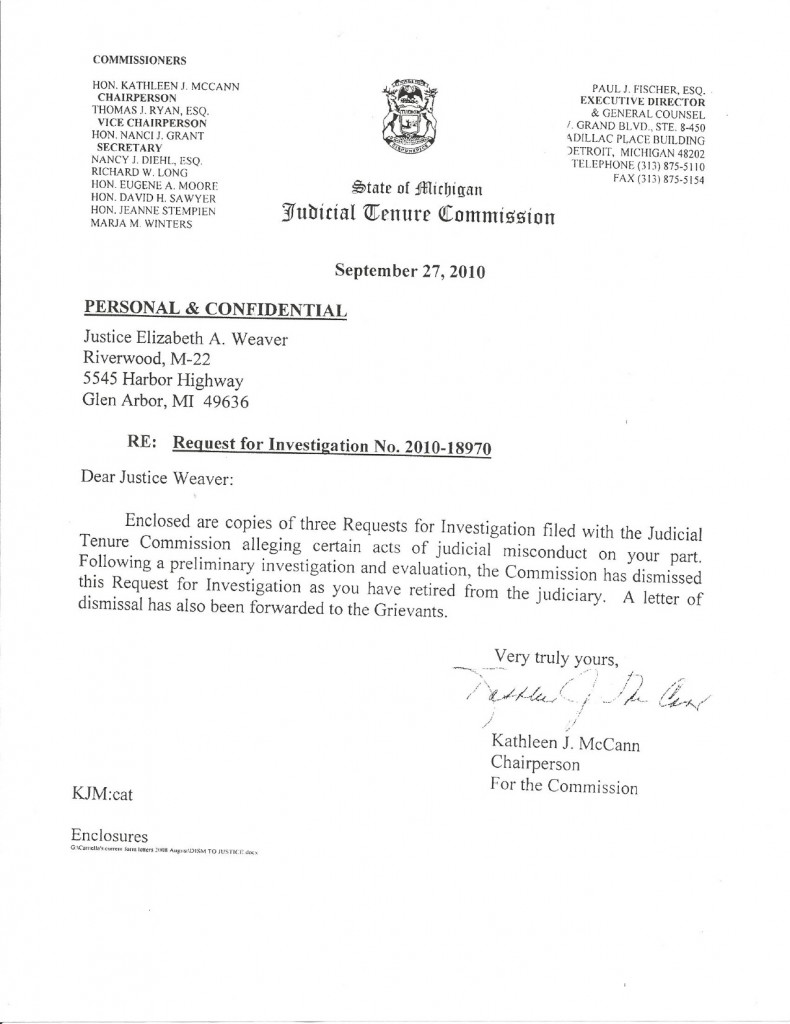
SECOND, she argues, even if the AGC had authority in this case, it couldn’t proceed because as an arm of the Michigan Supreme Court any recommendation for discipline against her would wind up before a court that had already judged her in its botched censure. These folks can in no way be considered objective; their opinions already are on record.
THIRD–and perhaps most important (and in Justice Weaver’s own words), “this is an abuse of the process.”
Here are some questions:
Is this really what the AGC should be doing? Mr. Agacinski and all his staff might find themselves between the retired justice who now heads one of the state’s largest agencies and a retired justice who is intent on court reform even if it means that she needs to reveal the inner workings of the court.
In pursing the matter, what is the Honorable Maura D. Corrigan revealing about herself?
If the matter moves forward, is it possible that the matter will wind up in a federal court?
If so, is it possible that all the machinations of those now and recently at the Supreme Court will be exposed?
Or will Justice Weaver be exposed as relating anything less than the truth? It hasn’t happened yet, and you can bet those working against her would love nothing more than to discredit her. They’ve worked at it for years. As for their record with the truth…well, we know with certainty that Chief Justice Robert Preston Young, Jr., is willing to lie for the sake of his own convenience. And a majority of the court elected him to serve as their leader.



